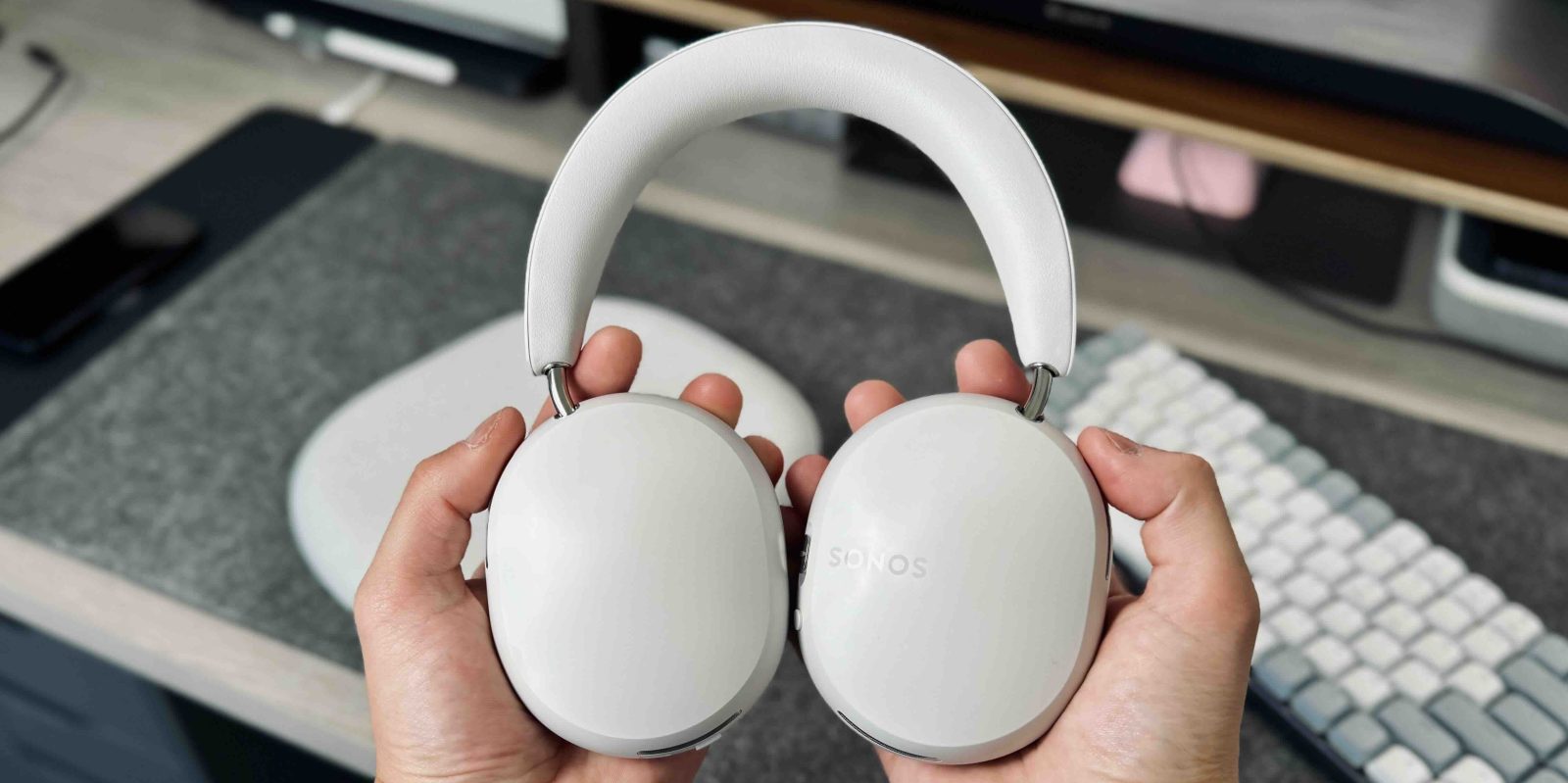
Sonos announced its new Sonos Ace Headphones in early May and, after much anticipation, are finally set to release on June 5th. I have been lucky enough to live with them for the last 10 days. I have used them in every scenario possible to see if these headphones are truly the new ‘Best in class’ and if I could recommend them at the $449 price point. In short, these headphones are awesome but there are some things you need to know. Let’s get into my full review!
Be sure to check out our video review below to get a closer look at these Sonos Ace headphones!
- Custom 40mm drivers in each earcup
- Eight microphones for noise cancellation and clear phone calls
- Supports spatial audio and Dolby Atmos
- Active Noise Cancellation & Aware mode
- Lossless Audio over Bluetooth and with a wired USB-C connection
- Adjustable EQ in the Sonos app
- Magnetically removable earcup cushions
- Up to 30 hours of battery life with ANC/Aware modes on
- Supports fast charging; get 3 hours of listening with a 3-minute charge
- Bluetooth 5.4
- Physical and tactile controls
- 2 different colors: Black & Soft White
Some of the specs that really jump out at me are the battery life and charge speed, the removable earcups, and the mic array. The spec list alone immediately puts these headphones in line with those of its competitors, such as the AirPods Max, Bose QC Ultras, and Sony WH1000XM5.
In the box
If you have never unboxed a Sonos product before, then you are in for a treat. Imagine an Apple product that is just more earthy. That is the best way to describe it. You can see the actual unboxing in our video review, but in the box, you get everything you need to get started, aside from a charging brick.
- The Sonos Ace
- USB-C to USB-C cable for charging and inline listening
- USB-C to 3.5mm cable
- Carrying case, color matching the color of the headphones
- Magnetic carrying case for cables
- Paperwork to get started



Design
The build quality and materials are the first things that get your attention when you see and hold these headphones. The Sonos Ace headphones achieve an impressive balance by remaining lightweight while incorporating high-quality materials such as stainless steel and soft-touch plastic, giving them a premium feel. At just 312 grams, they are notably lighter than the AirPods Max by about 70 grams, and they rest comfortably on the head with their memory foam earcups and headband.
The earcups are larger than those of the Bose QC Ultra to ensure you have a full and tight seal around your ear. They also provide the perfect amount of rigidity so it feels snug on your head and ears but not so much so that it gets uncomfortable during long listening sessions. This allows for them to stay on your head very well, even during some more intense activity. You can see how they stay on during a workout in our video here.
Another huge win, in my opinion, is that Sonos has opted for real tactile controls on the earcups, making it easy to interact. I’m particularly fond of these tactile buttons compared to touch-sensitive ones. Additionally, the modular design with removable ear cushions allows for easy replacement when necessary.
My only knock on the design is that they decided not to let it fold down into a smaller package. The earcups turn in, allowing it to lay flat but it doesn’t fold up like other headphones I’ve seen. Still relatively easy to travel with it though.
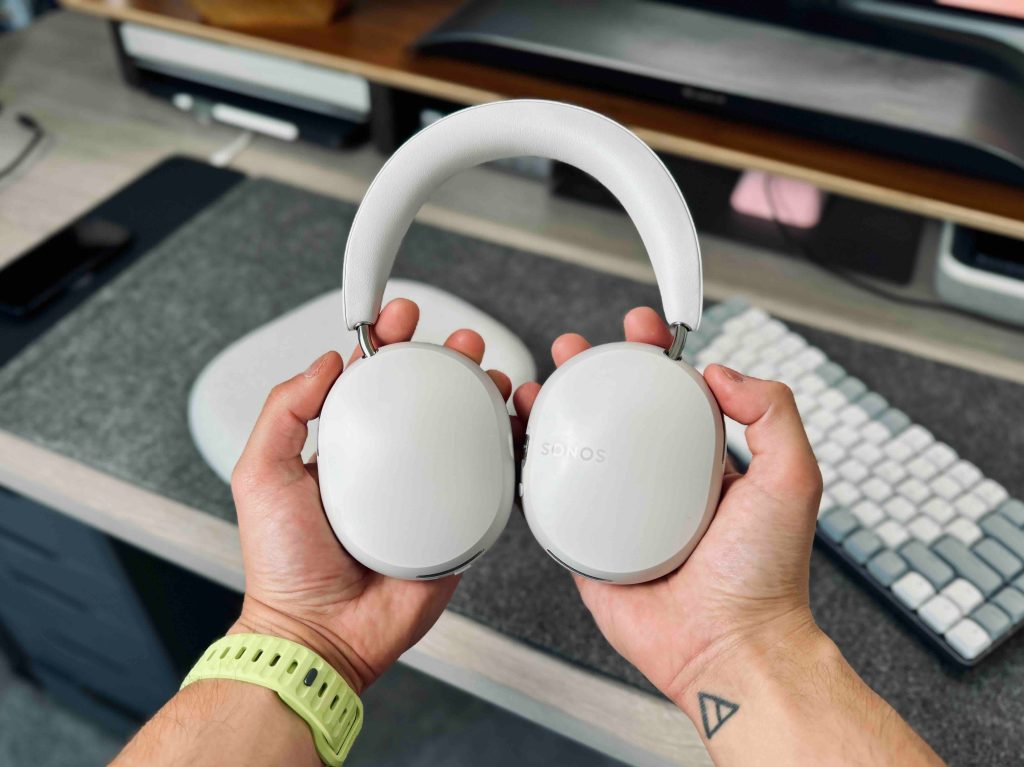

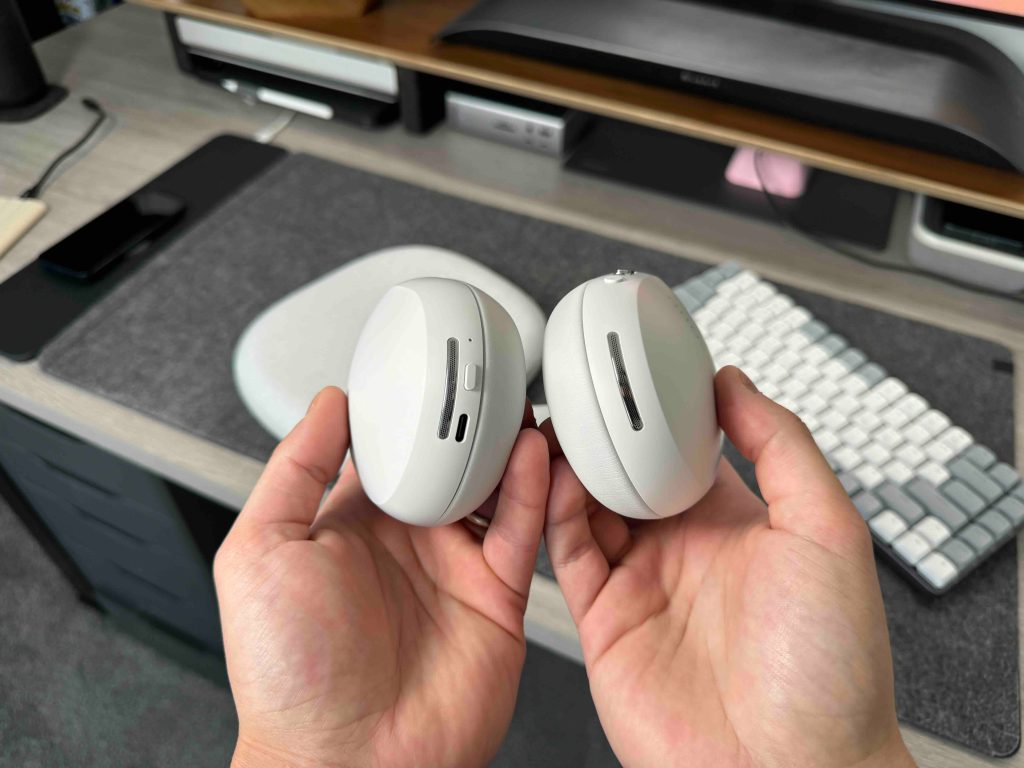
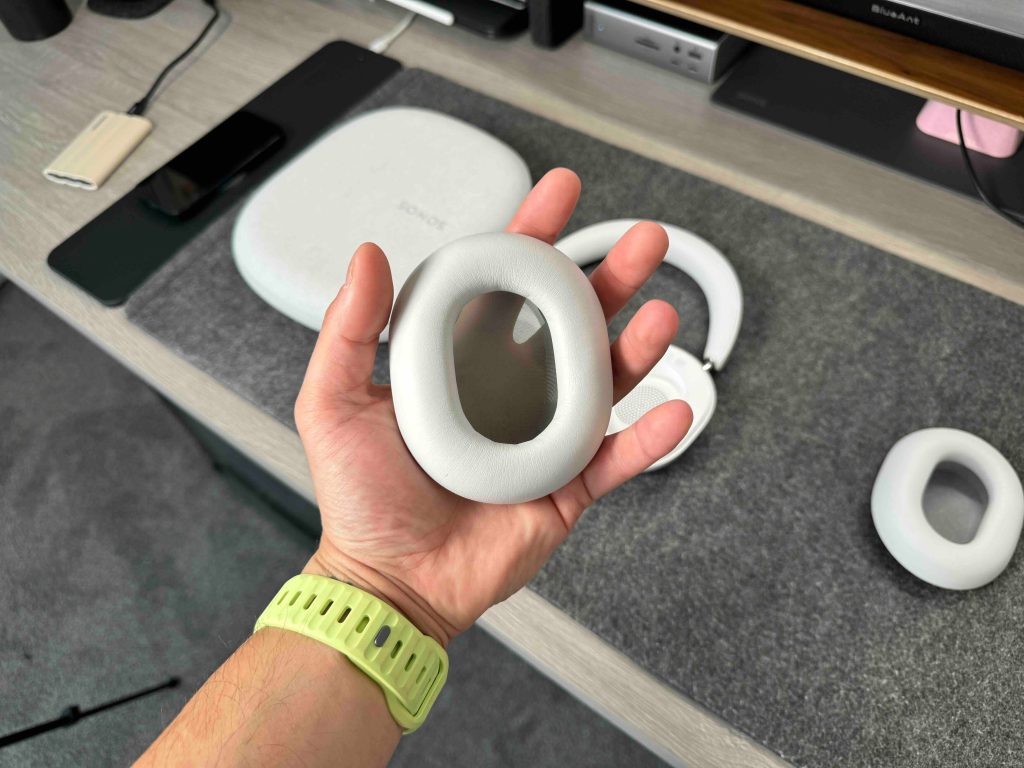
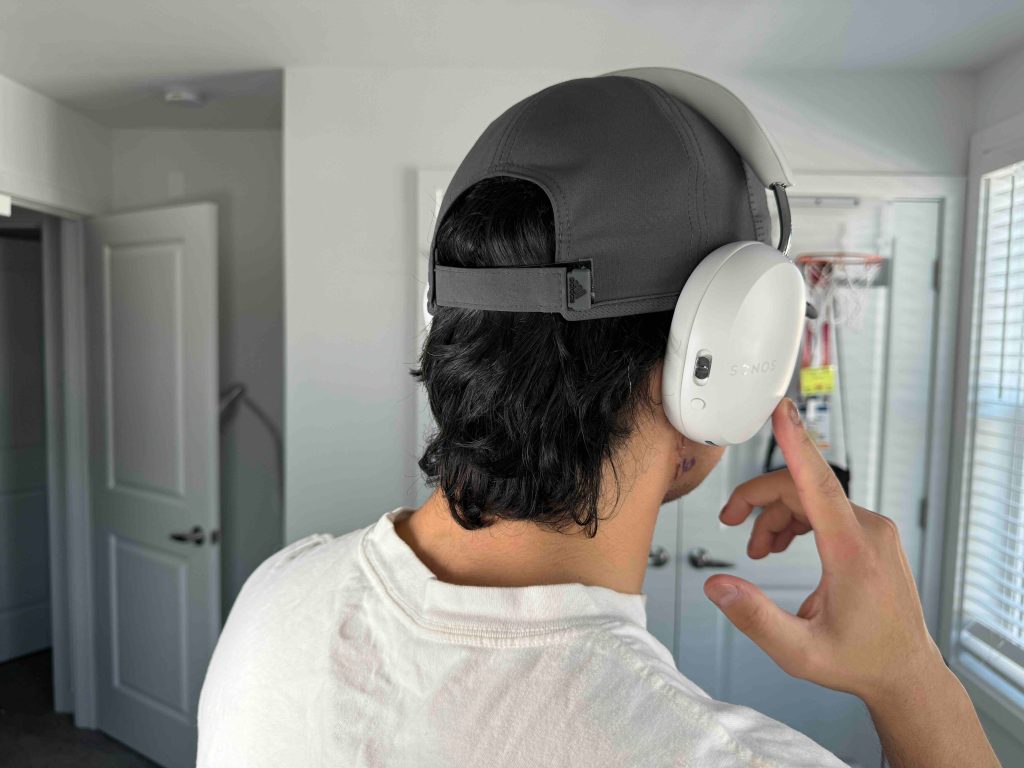
Connectivity
Setting up the Sonos Ace are very easy. If you are a current Sonos customer, then you might be aware that Sonos products actually use a combination of Wi-Fi and Bluetooth to connect. This is because most of their products aren’t meant to leave your house or office. Obviously, this is not the case with headphones. So, the Sonos Ace uses purely Bluetooth, no Wi-Fi, to connect to your devices. Since there is no Wi-Fi, there is no Airplay support for these.
Sonos recommends using the Sonos app to connect your headphones and initially go through an update process. But it is not necessary to use them. I used the app to connect myself, but after the initial setup and setting up my preferred EQ, I haven’t really gone back into the app. There was a 10-minute update that I had to wait on in order to start using them, which wasn’t the best experience, but once updated, it was ready to go.
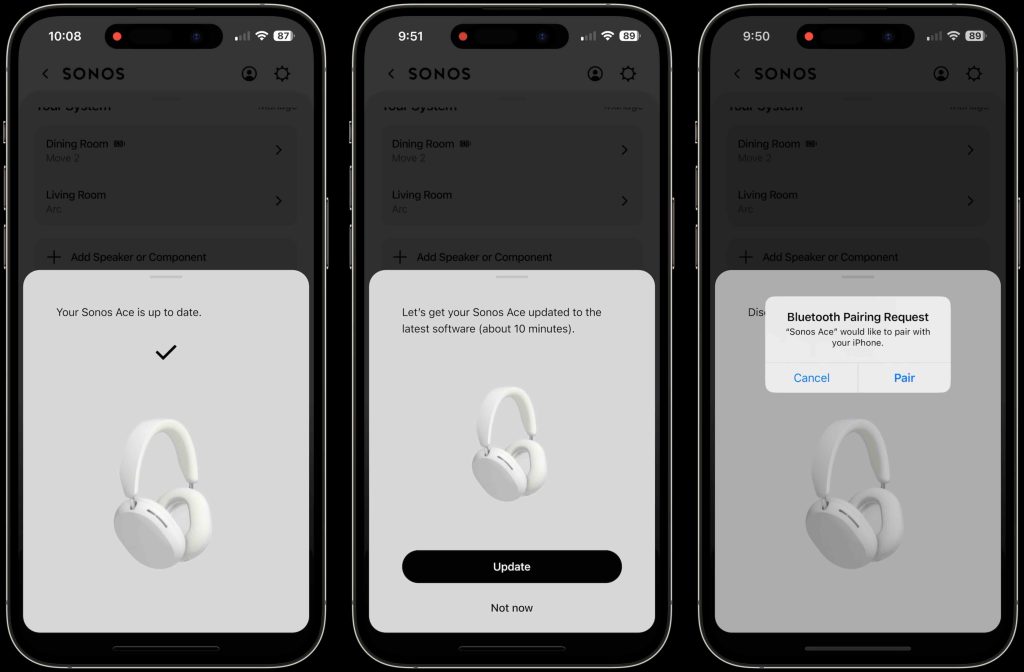
How do they actually sound?
This is where you find out if these headphones are worth the $449 price tag. Aside from the AirPods Max, they are the most expensive headphones in their class. Sound quality is tough to describe in writing or even a video, but these absolutely live up to the hype. I have put these headphones through extensive listening sessions with all types of media, from bass-heavy music to classical songs, podcasts, and, of course, phone calls.
On the music front, they can handle pretty much anything you throw at them. Vocals come through extremely crispy, and beats have a full range from great lows to clear highs. If you are into bass-heavy music, I recommend adjusting the EQ to be heavy on the bass to get that thumping sound. You can hear each layer of sound coming from different tracks, which I love. Sonos has always been known for delivering great sound quality with their speakers, and they just accomplished the same with their headphones.
The Sonos Ace provides ultra-clear vocals for podcasts and phone calls. When you turn on the active noise cancellations during a podcast, it feels like the person is next to you, telling you a story. So, let’s get into those features.
Listening features
The Sonos Ace give you all the features you want from a premium set of headphones. The ANC is second to none. They were able to shut out everything I threw at it, from a Dyson Vacuum to a subway commute, to people chattering, and even my toddler’s favorite show, Bluey. I also tested them with inconsistent sounds like wind and sirens, and they worked great. Wind noise was nonexistent, and so were those abnormal one-off sounds like sirens or construction.
I was blown away by the Ace’s transparency mode, which they call their Aware mode. I think this works so well because of the mic array it has. Somehow, it makes the sounds around sound even more natural and clear than they would when you don’t have anything on, but it does it without actually amplifying the sound or making it louder. It’s tough to describe, but it really gets the job done.


You can also just have the modes turned off and rely on the organic seal that the headphones give you. One thing to note is that these headphones need to have a charge. There is no passive listening feature. So if you wanted to plug in the 3.5mm jack and listen with the headset ‘off’, it won’t work.
The Sonos Ace supports head tracking, Spatial Audio, and Dolby Atmos. I 100% recommend trying out the head tracking because it is almost too good. If you move your head too quickly in one direction, you can really feel and hear the effects of the head tracking. I think it’s really cool.
The final feature to note is that it can connect to multiple devices. I recommend using the Sonos app to set up the multipoint connection. Once it’s set up, you are all set. I have it connected to my iPhone, iPad and Mac and was so impressed by how well it worked. I thought this was reserved for Apple headphones but I might say it works even better with the Sonos Ace. It IMMEDIATELY switches between your media devices, and it’s great.

Ecosystem features
Sonos is known for its ecosystem features. Most, if not all, of their products work better as you add more and more to them. You can easily connect and use the Sonos speakers around your house for a wireless and immersive listening experience. So Sonos wanted to bring that over to the Sonos Ace. On release, the headphones will support Audio Swap, which is a great feature. If you have a Sonos Arc or Beam, you can connect your Sonos Ace to them and then swap the sound from the sound bar to your headphones. It works seamlessly. So I was using my headphones to listen to the audio from my Xbox!
Another feature that is coming soon is called TrueCinema. I received a demo of this back in early May, and it was a great feature. You basically use your Sonos Arc to map the acoustic surroundings, and then it sends that to your headphones. Giving you a true and immersive multi-channel listening experience. But again, no word yet on a release for TrueCinema except for ‘coming soon.’


Other notes
There are some other aspects of the Sonos Ace to consider:
- There is no official IP rating. I worked out with them both in a gym setting and on a long, sweaty run, and they woke up fine. The removable earcups are nice to make it easy to clean. But again, no official IP rating.
- For the TrueCinema experience, it will be available after the launch through an update to the Sonos App. It will roll out with the Sonos Arc first, eventually trickle down Beam Gen 1 & 2 and the Ray.
- Unlike most Sonos audio products, the Sonos Ace connects via Bluetooth and doesn’t connect via Wi-Fi.
- Each Sonos Ace has a color-matched flat carrying case, a USB-C to USB-C cable, and a 3.5mm jack adapter.
Pricing & availability & do I recommend them?
The Sonos Ace are available for pre-order for $449 and will be available online and in-store on June 5th. As I mentioned earlier, it comes in 2 color options: Black and Soft White.
If you are currently in the market for a premium set of headphones, in my opinion, these are the new standard. They check every box I need, from sound quality to features to design and even within the ecosystem. I have been a Sonos customer for years, so I have always wanted a pair of Sonos headphones I can take anywhere. Now they are here, and they live up to the hype.
Let us know what you think. Will you be picking up a paid of the new Sonos Ace headphones? Are you a current Sonos customer? What are you most excited about? Let me know if its worth it to have a comparison review between Sonos Ace and Airpods Max!
FTC: We use income earning auto affiliate links. More.
